The Archaeological Site of Tiryns is located on the Peloponnese Peninsula in Greece. Tiryns was one of the most important cities of the Mycenaean civilisation. The Citadel of Tiryns is located on a rocky hill which rises about 18 metres above the surrounding Argolis Plain. Tiryns dates from 1400 BC-1200 BC. The Greek poet Homer referred to Tiryns as 'mighty walled Tiryns' because of its defensive walls. Tiryns was surrounded by Cyclopean walls, built of huge limestone boulders. Later Ancient Greeks believed that the walls were made by Cyclops. The walls of Tiryns are very impressive, they are 7-10 metres wide and 18 metres high. Just like the Acropolis of Athens and Mycenae, the fortified Citadel of Tiryns had its own underground water supply, which could be used during a siege. Tiryns was destroyed in 468 BC. All that remains of mighty walled Tiryns are the imposing ruins, the remains of a Cyclopean wall and tunnel, the foundations of the buildings and remains of the gates. Nowadays, the ruins of Tiryns are overgrown with red poppies. Tiryns is part of the UNESCO World Heritage Site: Archaeological Sites of Mycenae and Tiryns. The Archaeological Sites of Mycenae and Tiryns gained status as a UNESCO World Heritage in 1999. World Heritage Art: Wild Poppies at Tiryns
www.werelderfgoedfotos.nl © Copyright World Heritage Photos
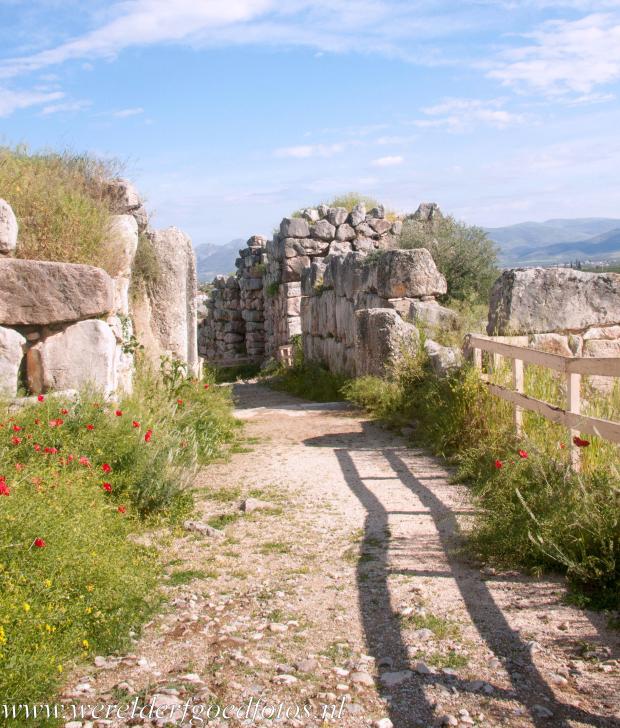
Archaeological Site of Tiryns: The entrance passage to the Great Gate, the main entrance to the Citadel of Tiryns. The Great Gate was similar in size and materials to the Lion Gate of Mycenae. The Cyclopean walls of Tiryns were built with massive limestone boulders, very large boulders were typical of the architecture of Tiryns and Mycenae.

Archaeological Site of Tiryns: The entrance passage to the Great Gate, the main entrance to the Citadel of Tiryns. The Great Gate was similar in size and materials to the Lion Gate of Mycenae. The Cyclopean walls of Tiryns were built with massive limestone boulders, very large boulders were typical of the architecture of Tiryns and Mycenae.
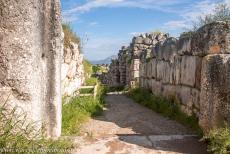
Archaeological Site of Tiryns: The Great Gate is the main entrance gate and leads to the Upper Citadel and the ruins of the palace. The main gate of Tiryns was probably similar to the famous Lion Gate of Mycenae. From the marks in the stone gate posts, archaeologists guessed, that the wooden door which hung between the posts of the gateway was 15 cm thick.
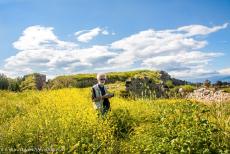
Archaeological Site of Tiryns: Today, parts of the ruins of Tiryns are overgrown with wild plants. Tiryns is situated on the Peloponnesus Peninsula in Greece. Tiryns was a hill fort, it was built in 1400 BC-1200 BC, it was excavated by the German amateur archaeologist Heinrich Schliemann in 1884-1885. The Archaeological Site of Tiryns was declared a UNESCO World Heritage in 1999.
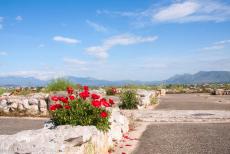
Archaeological Site of Tiryns: The Citadel of Tiryns offers an amazing view over the surrounding landscape. The palace of Tiryns was situated on the highest point of the Citadel of Tiryns. Tiryns was conquered by the Kingdom of Argos in 468 BC. The citadel was completely destroyed, the residents left the city or were deported to Argos. From this time, Tiryns remained uninhabited.

Archaeological Site of Tiryns: Nowadays, only the foundations of the palace of Tiryns remain, in spring, flaming red poppies are in full bloom on the ruins of Tiryns. The palace and courtyard inside the Citadel of Tiryns were built of enormous limestone boulders, the palace was covered by a timbered roof and supported by wooden beams. The floors were made of compacted clay.
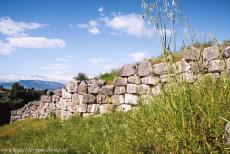
Archaeological Site of Tiryns: Tiryns was surrounded by a Cyclopean wall, built from enormous limestone boulders, ancient Greeks believed that the walls were made by Cyclops. Tiryns and Mycenae were among the largest and most powerful cities of the Mycenaean civilization, which flourished during the Late Bronze Age, approximately 1700–1100 BC.
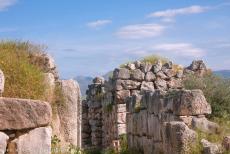
Archaeological Site of Tiryns: The main gate of Tiryns is leading to the palace of Tiryns, situated in the Upper Citadel of Tiryns. The noble class of Tiryns inhabited the Upper Citadel. The hidden underground cistern was situated in the Lower Citadel. The cistern was fed by a water well, very important to survive in case of a siege. Tiryns is situated near the Argolic Gulf.
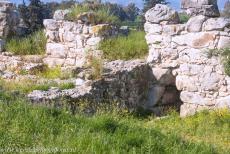
Archaeological Site of Tiryns: The entrance to a passage, the casemates and store rooms. The eastern side of the Citadel of Tiryns was protected by casemates. The casemates were linked by a long passage, situated between a double curtain of walls. Nowadays, the impressive corbelled passage of Tiryns is closed to the public.
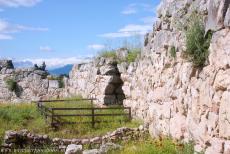
Archaeological Site of Tiryns: The Cyclopean wall nearby the underground passage, the wall was erected between the 14th and 13th century BC. The total lenght of the wall was 725 metres. The wall was between six and eight metres thick. Nowadays, the highest part is not more than seven metres, but originally it was about ten metres.
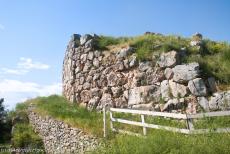
Archaeological Site of Tiryns: The Cyclopean walls of Tiryns. The Citadel and Cyclopean walls of Tiryns are now overgrown with wild plants such as poppies and yellow rapeseed. Later Ancient Greeks believed that the walls were made by Cyclops, in Greek mythology a race of one-eyed giants. The Hill Fort of Tiryns was described by the Ancient poet Homer as 'mighty walled Tiryns'.
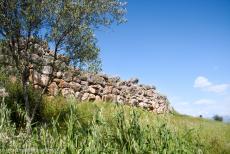
The Citadel of Tiryns dates from 1400 BC-1200 BC. The hill on which Tiryns was built is only 18 metres higher than the surrounding Argolis, a fertile plain on the Peloponnese in the south of Greece. Tiryns was one of the most important centres of the Mycenaean civilisation, this great civilisation laid the foundations of the Ancient Greek civilisation. Tiryns was destroyed in 468 BC.
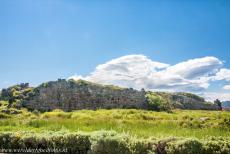
The ruins of the Citadel of Tiryns are located on a rocky hill, they now rises seven metres above the surrounding landscape. The Archaeological Site of Tiryns is situated nearby Mycenae, on the fertile plains of Argolis, near the town of Nafplio in Greece. According to Greek mythology, the Ancient city of Tiryns was founded by the hero Proetus, the legendary king of Argos and Tiryns.
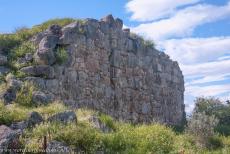
Archaeological Site of Tiryns: The Cyclopean walls of Tiryns were built with roughly shaped huge boulders, the holes between the massive limestone boulders were filled with smaller stones and clay. The walls of Tiryns were once 7 to 10 metres wide and 18 metres high, they are now lower but still very impressive. Tiryns is part of the UNESCO World Heritage Site: Archaeological Sites of Mycenae and Tiryns.
